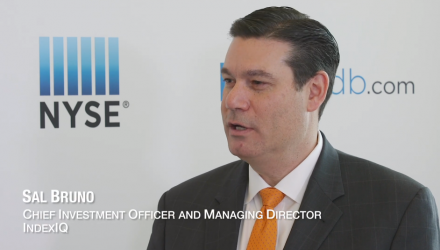Volatility can come out of no where and weigh on an investment portfolio, especially as we head toward the later end of a business cycle. Investors, though, can consider a number of exchange traded fund strategies that can help diversify a portfolio and hedge potential downside risks ahead.
“The markets really reminded us in 2018 where volatility looks and feels like, and It comes on quickly and it comes on strongly. So whether it was a sell-off we saw in February of 2018 or the fourth quarter of 2018 where the markets were down significantly, it was really a good reminder that it can come quickly and clients should be prepared to address volatility in their portfolios,” Sal Bruno, Chief Investment Officer and Managing Director, IndexIQ, said at Inside ETFs.
For example, Bruno highlighted the Index IQ Merger Arbitrage ETF (NYSEArca: MNA) as an alternative investment strategy that could provide lower correlations to traditional stock and bond holdings. MNA is a way to provide investors with a diversified approach to a group of takeover targets. The ETF employ a type of alternative, “directional hedge fund strategy” called merger arbitrage. The fund would capture the spread or difference between a stock’s trading price before a deal is announced and its eventual takeover price.
Merger arbitrage is a hedged, alternative investment strategy designed to take advantage of price discrepancies that exit for companies involved in a merger. The strategy would purchase companies at prices below the target price and lock in the difference, or spread. By targeting this spread, the generated returns are generally outside of normal fluctuations of the broader market.
A merger arbitrage investment strategy may help investors garner more consistent returns and possibly deliver a smoother ride, serving as an important capital preservation tool and providing drawdown protection in times of volatile market conditions.
Along with its drawdown protection potential, a merger arbitrage strategy can also improve the risk-to-return profile of a traditional investment portfolio since the drivers of return for this type of strategy are isolated from broad market moves.
Additionally, ETF investors interested in foreign market exposure but are also taking a more neutral view on foreign currency movements can consider a handful of 50% hedged/50% unhedged options, including the IQ 50 Percent Hedged FTSE International ETF (NYSEArca: HFXI), IQ 50 Percent Hedged FTSE Europe ETF (NYSEArca: HFXE) and IQ 50 Percent Hedged FTSE Japan ETF (NYS Arca: HFXJ). All three funds have approximately half their currency exposure of the securities in the underlying index hedged against the U.S. dollar on a monthly basis.
The forex market is volatile, and the U.S. dollar has been depreciating since the start of the year. Consequently, investors who have a more neutral stance on the foreign exchange outlook may consider a 50% hedged international investment as a way to limit volatility in their international exposure due to a sudden currency swing.
IndexIQ research has shown that a 50% currency hedged approach can reduce the potential risk of misreading extreme currency movements in either direction and can also have a dampening effect on volatility, which may help investors capture any further upside potential while hedging against downside risks associated with harmful currency moves.
Watch the full interview between ETF Trends CEO Tom Lydon and Salvatore Bruno:
For more ETF-related commentary from Tom Lydon and other industry experts, visit our video category.
